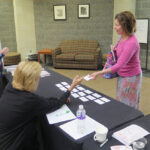
From left, seventh-graders Emma Anselm, Cameron Ritchie and Emma Anderson work on a project in Spanish class at Lourdes Catholic School in Bettendorf.
By Anne Marie Amacher
The Catholic Messenger
BETTENDORF — It’s a different way of doing Spanish. Teacher Tori McCollum uses a comprehensible input program (CI) to teach Spanish to her junior high students at Lourdes Catholic School instead of the traditional textbook and workbook.
As a new teacher to Lourdes this year, she started out with the Spanish textbook-teaching approach. But she discovered that interaction among students led to better understanding of the language. Principal Jennifer Alongi sent McCollum to the Iowa World Language Association conference in Ankeny, Iowa, earlier this fall. There the speakers talked about the Total Physical Response method as a way of assessing student learning.
McCollum returned to school with a new method of teaching: the Emergent Curriculum with Comprehensible Input. “She is focusing on the most crucial of the ‘sweet 16’ — the 16 language structures that make up 75 percent of spoken thought,” Alongi said.
“Before the conference, I had the dream where we could teach a second language the way we learned the first, by immersion and helping kids find confidence in the language,” McCollum said. “I have been out of the classroom for 10 years (to raise her family), and where I taught previously was not using a CI approach, but a more traditional, leveled curriculum.”
The CI method works well with students at different ability levels — from beginners to “heritage” speakers who speak Spanish at home. “We literally discuss, in language they understand, things that are very important to them (which keeps them interested and engaged in the learning),” McCollum said.
“It’s very easy for me to meet the heritage speaker in a different way, because I can begin working with her on refining and correcting her sentences. My true ‘level 1’ students are not getting as much active correction from me, but more repetition of the correct language structures.”
“Our seventh-graders are responding well,” Alongi said. During a recent observation of the class, she estimated that 80 percent of the instruction and student responses were in Spanish. “The students absorb it like a sponge and when they get it, they start trickling out in Spanish,” McCollum said. “My goal is not accuracy but fluidity and comprehension. The students are more energized. They are pleased to be here. They are having fun.”
To begin class, McCollum greets the students at the doorway and waits for them to say the Spanish password of the day in order to enter the classroom. Students form a circle in the classroom and their teacher walks within the circle to give her lesson for the day. She holds a marker in her hand and asks students for the word in Spanish: el marcador. As she speaks, she weaves in the Spanish words for colors and other items which will later be used for a project. She asks the students questions in Spanish, including trick questions, to see how they respond.
One day last week, they played the game “rock, paper, scissors” as part of the interactive lesson. Students paired up and said the words in Spanish and used the game’s traditional hand motions.
Afterwards, they participated in a lesson that required them to translate five English words into Spanish to share what they were thankful for. One student did not know the meaning of the word “libro.” Speaking Spanish, McCollum asked the class to describe “libro” (which means book) without using English. One student used his hands to pretend he was opening a book. Another student grabbed a book. Gestures and hand motions are acceptable communication alternatives.
The lesson ended with students creating paper turkeys on which to express gratitude. They wrote the phrase “doy gracias por” — which means “I give thanks for” — on the turkey’s body. On the turkey’s five feathers they wrote five Spanish words.
Students don’t take tests in the class, but are assessed on their learning progress, McCollum said.
Seventh-grader Alexis Fessenden said she liked this method of learning Spanish because “We get to interact.”
Some teachers in Iowa have used this method for years, said McCollum, who will attend a conference next June in Nevada, Iowa, to learn more.











